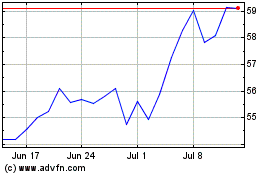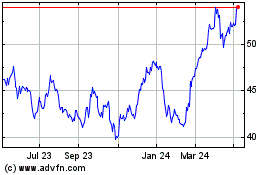Stress Test Pressure May See U.K. Banks Cut Dividends
November 27 2015 - 9:30AM
Dow Jones News
LONDON—Britain's largest banks could be forced to cut dividends
as the Bank of England steps up pressure on them to hold more
capital.
Analysts say U.K. regulators are making renewed efforts to get
banks to hold more capital through increasingly stringent stress
tests, even as the results of the most recent exam, due Tuesday,
are expected to show a perfect pass rate.
The latest test studied how seven major banks—HSBC Holdings PLC,
Barclays PLC, Lloyds Banking Group PLC, Standard Chartered PLC,
Royal Bank of Scotland Group PLC, Santander UK and Nationwide
Building Society—would fare in what have turned out to be real life
scenarios of an emerging markets downturn and low oil price.
The banks should all be strong enough to pass, but analysts say
the focus now is on the Bank of England's previously announced
plans to make the tests even harder from next year. Banks that
don't pass stress tests can be forced to raise additional capital
or postpone paying shareholder dividends.
"We don't expect outright capital deficits on Tuesday," said
Peter Richardson, a banking analyst at Berenberg. "What we do see
is a growing headwind of tougher tests and higher hurdle rates to
pass them. These will continue to erode expectations of dividends,"
he said.
Even before the stress tests, some banks have been revising
their dividend plans. Standard Chartered canceled paying a year-end
dividend and Barclays reversed plans to raise its payout. In both
cases, the moves marked an effort by the banks to conserve capital
as they undergo major restructurings. British banks, while widely
seen as healthier than many of their continental European rivals,
are still struggling to reshape their businesses to fit a tougher
economic and regulatory climate for banking.
From next year, the regulatory demands are set to get even
tougher, as the Bank of England raises the level of minimum capital
needed by the seven banks to pass its annual test. Each bank will
have a unique number of how much is enough, reflecting Bank of
England requirements and additional global buffers for the
country's four systemically important banks—Barclays, HSBC, RBS and
Standard Chartered.
The move ties in with a growing reliance on stress tests by the
Bank of England and regulators in the U.S. and elsewhere to predict
how their banking systems would cope in stressful conditions.
"Stress tests (are) increasingly the primary way banks are
regulated" in Britain, analysts at Morgan Stanley wrote in a report
Tuesday, calling the health checks "a gate on payouts". They said
higher capital levels than banks' current targets "could be needed
for major U.K. banks to give comfort that thresholds are not likely
to be breached during future stress tests".
Stress tests have become a key tool for the BOE and other
banking regulators to determine whether banks have enough capital
to withstand shocks and prevent a repeat of the financial crisis of
2008. The British tests assess the capital strength of individual
banks, as well as the overall stability of the country's financial
system. Banks that don't pass the tests can be forced to raise
additional capital or postpone paying shareholder dividends.
Banks also face the possibility on Tuesday of a new capital
buffer on their domestic lending, with signs that the Bank of
England's Financial Policy Committee may be poised to make its
first use of a so-called countercyclical buffer.
Bank of England Governor Mark Carney told lawmakers this week
that the central bank is concerned about how borrowing at low rates
over an extended period has fueled Britain's property market and
other lending, and that the extra buffer could help smooth out
problems.
At the core of officials' concern is a pickup in credit growth.
Overall lending to consumers rose at a 3% annual rate in September,
and growth in unsecured borrowing has accelerated to an annual 8%
rate, according to BOE data.
While still well below the 10% annual growth in overall consumer
lending that prevailed in the years before financial crisis struck
in 2008, economists say the central bank could act to prevent
credit growth accelerating further
"They are warming up to do it," said Richard Barwell, a senior
economist at BNP Paribas Investment Partners and a former BOE
official.
Jason Douglas contributed to this article.
Write to Margot Patrick at margot.patrick@wsj.com
Access Investor Kit for "Lloyds Banking Group"
Visit
http://www.companyspotlight.com/partner?cp_code=P479&isin=GB0008706128
Access Investor Kit for "Barclays Plc"
Visit
http://www.companyspotlight.com/partner?cp_code=P479&isin=GB0031348658
Access Investor Kit for "Barclays Plc"
Visit
http://www.companyspotlight.com/partner?cp_code=P479&isin=US06738E2046
Subscribe to WSJ: http://online.wsj.com?mod=djnwires
(END) Dow Jones Newswires
November 27, 2015 09:15 ET (14:15 GMT)
Copyright (c) 2015 Dow Jones & Company, Inc.
Lloyds Banking (LSE:LLOY)
Historical Stock Chart
From Mar 2024 to Apr 2024

Lloyds Banking (LSE:LLOY)
Historical Stock Chart
From Apr 2023 to Apr 2024
